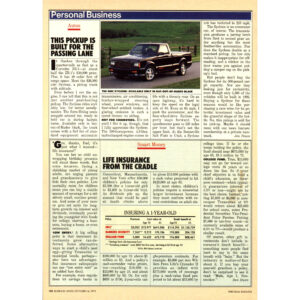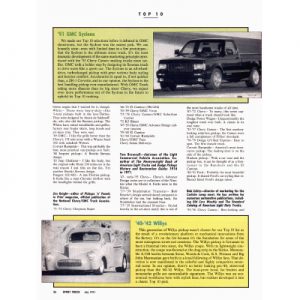Super Street Truck

By Matt Hardesty
Within the last few years, trucks, or pickups as many prefer to call them, have changed dramatically in both exterior and interior design. Square outward looks, bare interior accommodations, rough rides and low-geared, high-torque six-cylinder motors have given way to awe-inspiring, new-generation sport trucks like the Chevy SS 454. Although this change in the present-day truck market has come as a breath of fresh air, nothing, but nothing has blown away all of the traditional rules like the GMC Syclone.
Bursting upon the performance automotive scene early last year, the new Syclone promised a horsepower-hungry public a versatile vehicle that could haul a heavy load as well as run a hot quarter-mile. After a seemingly endless wait, the little Syclone finally made it to selected GMC dealers across the country, and just as everyone expected, this all-wheel-drive, 4.3-liter turbo V6 S-15 pickup was very impressive … but not perfect.
For most performance-minded people who invested their hard-earned cash into this radically new sport truck, the most disappointing aspect of the whole truck was the maze of confusion and disarray of hoses, wires and electrical components under the hood. It seemed the Syclone’s new “international” motor would be more of a “foreign” nightmare when it came time to change the plugs or any other maintenance-related necessities. Those who thought that adding performance racing equipment to the Syclone would be as easy as the ones used on the ever-popular turbo Grand Nationals soon realized how terribly wrong they were-this was definitely not a turbo Buick.
So where does one begin to look for added performance in a Syclone? A chip? Bigger turbo? Intercooler? This was the same question posed by Kenne Bell Performance Products in Rancho Cucamonga, California (714/941-6646). Kenne Bell’s name is synonymous with Buick performance, whether it be V6, V8 or turbo power, but when the Syclone arrived, Bell shifted gears a little to develop the first performance racing bolt-ons for this stout turbo truck.
Before attacking any such project, the first step is understanding what your stock subject is. In this case, the turbo 4.3 V6 in the Syclone is basically a stock motor with a few alterations, including the turbo. The 4.3-liter block has the same basic dimensions as the standard 5.7-liter Chevy 350. The heads and camshaft are also carryover features from the standard Vortech 4.3-liter, normally-aspirated engine. The Syclone engine receives its boost in power from the Mitsubishi TD06 turbo, a liquid-to- air intercooler, port fuel injection and GM High Energy Ignition System with Electronic Spark Control to alleviate dangerous knock and ping. What this equates to is a system similar to the Buick’s turbo (a system with which Kenne Bell is very familiar with), although the packaging in the Syclone is much more cramped and slightly more complicated.
Kenne Bell’s president, Jim Bell, has spent much time and effort In understanding and improving the new Syclone and its 280-horsepower motor. Numerous baseline tests on a stock Syclone were conducted at Los Angeles County Raceway in Palmdale, California, by Jim and his staff to determine how they could pull extra horsepower out of a seemingly caged animal. Just as a doctor uses specialized and sensitive equipment to check patients. the Kenne Bell Syclone was monitored by some pretty advanced computer equipment from Race and Performance Monitoring (RPM) in Scottsdale, Arizona (602/483-7885). RPM’s DS-1000 computer data-logging equipment was used to determine such functions as: speed, rpm. boost, throttle position, exhaust temperature, exhaust pressure. manifold air temperature and fuel pressure. This system proved to be invaluable in determining the Syclone’s weak areas as it traveled down the straightaway.
Initial quarter-mile times for the stock Kenne Bell truck were very quick, just as anticipated: 13.48 @ 96.80 mph. Knowing full well that the Syclone was not performing to its full capabilities. Jim Bell set to work on a flurry of bolt-ons guaranteed to increase power and decrease blast times. The first modification to the Syclone was the addition of a billet aluminum adjustable fuel pressure regulator. The regulator allowed for a higher idle pressure (50 psi over 40 psi stock) and increased wideopen throttle fuel pressure (70 psi rather than 60 psi stock) that effectively reduced detonation during heavy acceleration and eliminated low-rpm surge and bog.
The next obvious step was modifying the computer chip. Unlike most GM computer chips, the one used on the Syclone is very different in size and shape. Two new performance chips were tried: the Streetmaster and the Shoot Out 1. Both increased power and proved to be effective in lowering ETs, although the Streetmaster requires 94-octane fuel and the Shoot Out 1 should be used with racing fuel or aviation gas only. To complement the new chips, the twisted, restricted and utterly useless stock air intake was removed in favor of a high-flow assembly and smaller battery, leaving more space for a better fit. To find out how the Syclone would react to a free-flowing exhaust, the stock dual mufflers and tailpipes were removed and replaced with a three-inch-diameter straight pipe. This not only shaved quarter-mile times, but weighed 30 pounds less than stock.
Experimentation with the electronic lockup torque converter and an override switch that locks up the converter in second gear was good for another two-tenths. After an 11-inch Hi-Stall converter was also added, another two-tenths was gained.
The three largest improvements that pushed the Syclone into the 11-second range were the Stage 2C turbo upgrade kit (larger Garrett turbo), Mark 1 TR Turbo Roller Cam (.440 lift/205 duration, compared to .345 lift/176 duration stock), and the Turbo Swirl Ported Heads. The larger Garrett turbo provides increased boost due to its larger turbine and compressor. The roller cam replaces the stock cam used on the normally-aspirated 4.3-liter engines: an obvious gain was anticipated with the new cam and its addition pushed the Syclone to a blistering quarter-mile time of 11.99 @ 110.57. The aluminum Chevrolet heads provide dramatic airflow increases for both intake and exhaust, and because the stock heads are of ••fast burn,, design they tend to be more sensitive to detonation. This last addition has dropped the Syclone ‘s ET nearly two-tenths lower to 11.74.
If you thought the Syclone was impressive in stock form, the Kenne Bell-treated truck will rearrange your definition of “impressive” in a big hurry. Those planning to race their Syclones will find these new performance pieces to be an absolute blessing since they help take out so much of the guesswork and labor in trying to understand the turbo 4.3 V6. Additional good news for Syclone owners comes from the fact that Kenne Bell is developing more goodies: a trick ram-air intercooler is planned to replace the stock liquid-to-air unit and custom headers are in the works for the serious drag racer. Bell has also designed a four-gauge bezel that fits directly in front of the automatic shifter, providing for instant and accurate information on boost, oil pressure. temperature and fuel pressure. Stay tuned for more information on the Kenne Bell Syclone products. They are sure to liven up the performance of your stock caged animal.





